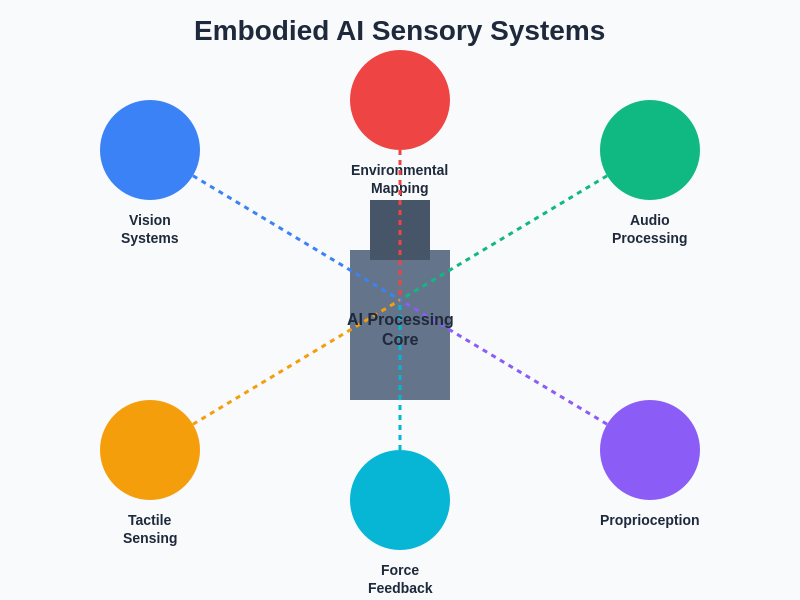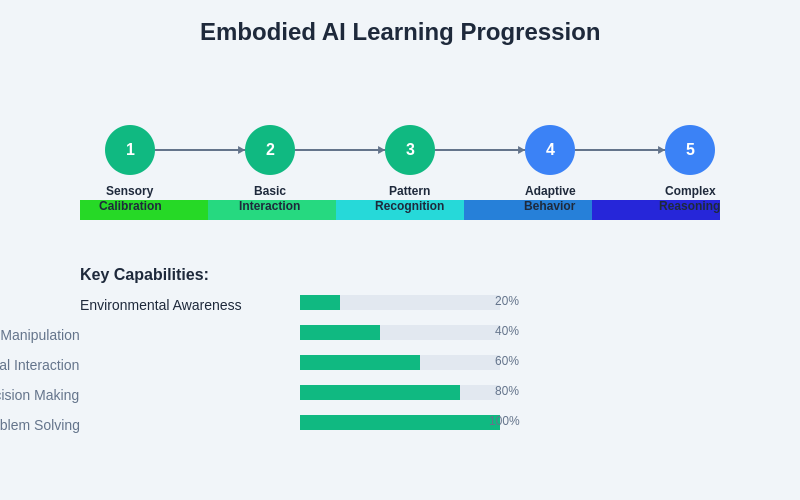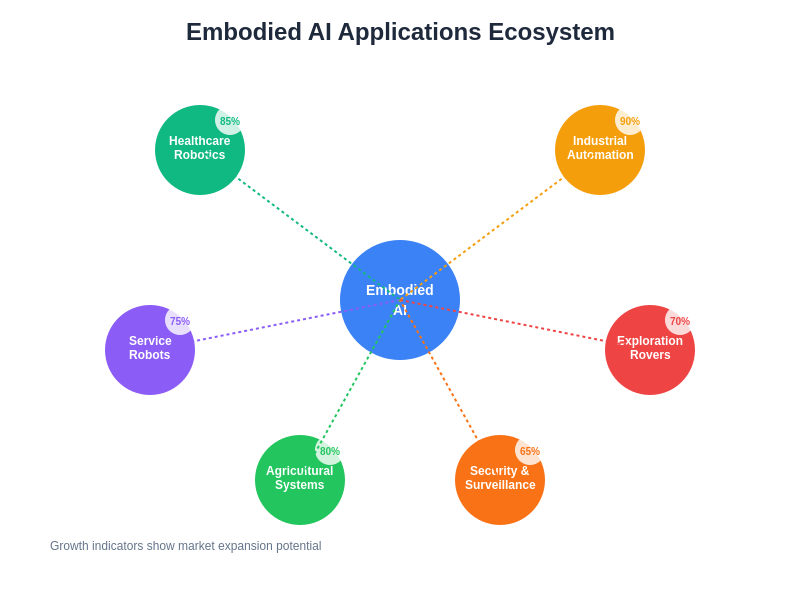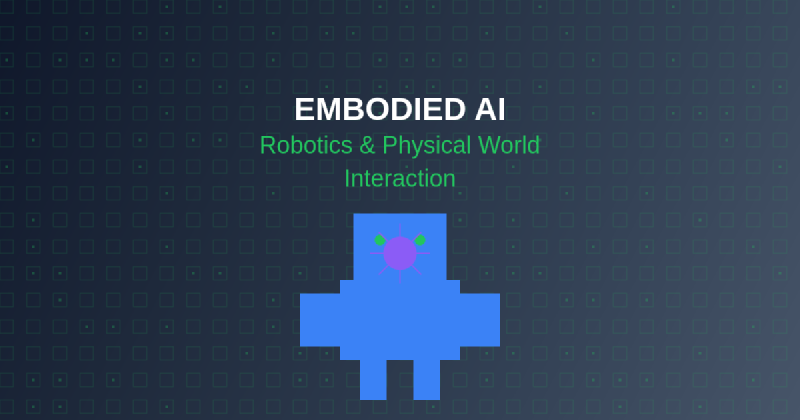The convergence of artificial intelligence and robotics has reached a pivotal moment with the emergence of embodied AI, a revolutionary approach that enables machines to understand, navigate, and interact with the physical world in ways that were previously confined to the realm of science fiction. Unlike traditional AI systems that process abstract data in digital environments, embodied AI represents a fundamental shift toward intelligent systems that possess physical forms and can engage with their surroundings through sophisticated sensory mechanisms, adaptive learning algorithms, and dynamic motor control systems.
Discover the latest breakthroughs in AI and robotics as researchers and engineers push the boundaries of what machines can achieve in real-world environments. This technological evolution represents more than just an advancement in robotics; it constitutes a paradigm shift that challenges our understanding of intelligence, consciousness, and the relationship between mind and body in artificial systems.
The Foundations of Embodied Intelligence
Embodied AI fundamentally differs from conventional artificial intelligence by emphasizing the critical importance of physical interaction in the development of intelligent behavior. Traditional AI systems operate in abstract computational spaces, processing information through algorithms and neural networks without direct connection to the physical world. In contrast, embodied AI recognizes that true intelligence emerges from the dynamic interaction between an agent’s cognitive processes and its physical environment, creating a feedback loop that enables continuous learning and adaptation.
This approach draws inspiration from biological systems, where intelligence is inherently tied to physical embodiment. Just as human intelligence develops through sensorimotor experiences and physical interaction with the environment, embodied AI systems learn and evolve through direct engagement with their surroundings. The physical body becomes not merely a tool for executing commands, but an integral component of the cognitive architecture that shapes how the system perceives, processes, and responds to environmental stimuli.
The theoretical foundations of embodied AI rest on the premise that intelligence is not simply a computational process but an emergent property that arises from the complex interactions between perception, action, and environmental feedback. This perspective has profound implications for how we design and implement intelligent robotic systems, requiring a holistic approach that considers the intimate relationship between cognitive processes and physical capabilities.

The integration of multiple sensory modalities creates a comprehensive perceptual framework that enables embodied AI systems to understand and interact with their environment through sophisticated feedback loops that mirror biological intelligence systems.
Advanced Sensory Systems and Perception
The development of sophisticated sensory systems represents a cornerstone of embodied AI technology, enabling robots to perceive and interpret their environment with unprecedented accuracy and nuance. Modern embodied AI systems integrate multiple sensory modalities including visual perception through high-resolution cameras and depth sensors, auditory processing through advanced microphone arrays, tactile sensation through pressure and texture sensors, and proprioceptive awareness through internal position and movement monitoring systems.
Visual perception in embodied AI has evolved far beyond simple object recognition to encompass complex scene understanding, spatial reasoning, and dynamic object tracking. Advanced computer vision algorithms enable robots to identify objects, estimate distances, understand spatial relationships, and predict movement patterns in real-time environments. These systems can process visual information at multiple scales, from detailed texture analysis for manipulation tasks to broad environmental mapping for navigation purposes.
Tactile sensing has emerged as a particularly crucial component of embodied AI systems, providing robots with the ability to understand material properties, detect contact forces, and perform delicate manipulation tasks. Advanced tactile sensors can distinguish between different textures, measure applied forces with high precision, and even detect temperature variations, enabling robots to interact with objects in ways that were previously impossible for artificial systems.
Experience advanced AI capabilities with Claude for complex reasoning and analysis that complements the physical intelligence of embodied AI systems. The integration of multiple sensory modalities creates a rich perceptual foundation that enables robots to build comprehensive understanding of their environment and make informed decisions about physical interactions.
Learning and Adaptation in Physical Environments
One of the most remarkable aspects of embodied AI systems is their ability to learn and adapt through physical interaction with their environment. Unlike traditional machine learning approaches that rely on pre-existing datasets, embodied AI systems can acquire knowledge through direct experience, trial and error, and continuous interaction with the physical world. This experiential learning approach enables robots to develop skills and understanding that are specifically tailored to their operating environment and physical capabilities.
Reinforcement learning has proven particularly effective in embodied AI applications, where robots can learn optimal behaviors through exploration and reward-based feedback. These systems can adapt their strategies based on the outcomes of their actions, gradually improving their performance through iterative refinement. The physical embodiment provides immediate and tangible feedback that guides the learning process, creating a natural training environment that mirrors how biological systems acquire new skills.
Transfer learning represents another crucial component of embodied AI systems, enabling robots to apply knowledge gained in one context to new situations and environments. This capability is particularly important for practical applications, where robots must be able to generalize their skills and adapt to variations in their operating conditions. Advanced embodied AI systems can learn fundamental principles of physical interaction that remain applicable across different tasks and environments.
The integration of neural plasticity concepts into embodied AI architectures has enabled the development of systems that can continuously adapt and evolve their capabilities over time. These adaptive systems can modify their neural networks based on accumulated experience, developing increasingly sophisticated understanding of physical interactions and environmental dynamics.

The developmental progression of embodied AI systems follows a structured pathway from basic sensory calibration through complex reasoning capabilities, with each stage building upon previous achievements to create increasingly sophisticated behavioral repertoires.
Human-Robot Collaboration and Social Interaction
The advancement of embodied AI has opened new possibilities for meaningful collaboration between humans and robots in shared physical spaces. Modern embodied AI systems are designed not merely to operate alongside humans but to understand human intentions, predict human behavior, and coordinate their actions to enhance collaborative efficiency. This requires sophisticated understanding of human psychology, social dynamics, and communication patterns that extend far beyond simple voice recognition or gesture detection.
Social robotics within the embodied AI framework encompasses the development of robots that can interpret emotional states, respond appropriately to social cues, and engage in natural interaction patterns that feel intuitive to human collaborators. These systems must balance autonomous decision-making capabilities with responsiveness to human guidance and feedback, creating a dynamic partnership that leverages the strengths of both human creativity and robotic precision.
The design of embodied AI systems for human collaboration requires careful consideration of safety protocols, predictable behavior patterns, and clear communication mechanisms that enable humans to understand and anticipate robotic actions. Advanced systems incorporate multimodal communication capabilities that include verbal interaction, gesture recognition, facial expression analysis, and contextual understanding of social situations.
Trust development between humans and embodied AI systems represents a critical factor in successful collaboration. These systems must demonstrate consistent behavior, clear communication of their capabilities and limitations, and appropriate responses to unexpected situations that build confidence and facilitate effective teamwork.
Industrial Applications and Manufacturing Integration
The integration of embodied AI into industrial and manufacturing environments has revolutionized production processes by enabling robots to perform complex tasks that require adaptive intelligence and physical dexterity. Unlike traditional industrial robots that operate according to predetermined programs, embodied AI systems can adapt to variations in materials, environmental conditions, and production requirements without extensive reprogramming or human intervention.
Quality control applications have particularly benefited from embodied AI capabilities, where robots can inspect products using multiple sensory modalities, identify defects or variations, and make real-time decisions about product acceptance or rejection. These systems can learn to recognize subtle quality indicators that might be difficult to define in traditional programming approaches, improving overall quality assurance processes.
Assembly operations have been transformed through embodied AI systems that can handle complex multi-step processes, adapt to component variations, and coordinate with other robots or human workers in flexible production environments. These systems can learn optimal assembly strategies through experience and adapt their approaches based on changing requirements or component specifications.
Predictive maintenance applications leverage the sensory capabilities of embodied AI systems to monitor equipment conditions, detect early signs of wear or failure, and schedule maintenance activities proactively. This approach reduces downtime and improves overall equipment effectiveness by addressing issues before they result in system failures.
Healthcare and Medical Applications
The healthcare sector has emerged as a particularly promising application domain for embodied AI technology, where robots can provide assistance with patient care, medical procedures, and rehabilitation activities. Medical robots equipped with embodied AI capabilities can adapt to individual patient needs, learn from therapeutic interactions, and provide personalized care that responds to changing patient conditions.
Surgical applications of embodied AI have advanced significantly, with systems that can assist surgeons by providing enhanced precision, tremor compensation, and real-time guidance during complex procedures. These systems combine advanced sensory capabilities with precise motor control to enable minimally invasive procedures that reduce patient trauma and recovery times.
Rehabilitation robotics has been transformed through embodied AI systems that can adapt therapy programs to individual patient progress, provide motivational feedback, and adjust exercise parameters based on real-time assessment of patient capabilities. These systems can monitor patient movements, detect fatigue or distress, and modify therapy sessions to optimize therapeutic outcomes.
Elder care applications represent a growing area of embodied AI deployment, where robots can provide companionship, monitor health indicators, assist with daily activities, and provide emergency response capabilities. These systems must demonstrate high levels of reliability, empathy, and understanding of human needs to be effective in care environments.

The diverse application domains of embodied AI demonstrate the technology’s versatility and growing market potential, with healthcare robotics and industrial automation leading the expansion into real-world deployment scenarios.
Enhance your research capabilities with Perplexity to stay current with the latest developments in healthcare robotics and embodied AI applications. The intersection of artificial intelligence and healthcare continues to generate innovative solutions that improve patient outcomes and healthcare delivery efficiency.
Environmental Exploration and Autonomous Navigation
Embodied AI systems have demonstrated remarkable capabilities in environmental exploration and autonomous navigation, enabling robots to operate effectively in unknown or dynamic environments without human guidance. These systems combine advanced mapping algorithms with real-time sensory processing to build comprehensive understanding of their surroundings while simultaneously planning optimal paths and avoiding obstacles.
Simultaneous Localization and Mapping (SLAM) technologies have been enhanced through embodied AI approaches that enable robots to create detailed environmental maps while tracking their own position and movement through space. These systems can operate in challenging conditions including low-light environments, cluttered spaces, and dynamic settings where obstacles may move or change position.
Outdoor exploration applications have benefited from embodied AI systems that can adapt to varied terrain conditions, weather variations, and unexpected obstacles. These robots can learn to recognize different surface types, adjust their locomotion strategies accordingly, and make intelligent decisions about route planning based on environmental conditions and mission objectives.
Search and rescue operations represent a critical application area where embodied AI systems can operate in dangerous or inaccessible environments to locate and assist human survivors. These systems must demonstrate high levels of autonomy, reliability, and decision-making capability while operating under challenging conditions with limited communication capabilities.
Challenges and Technical Limitations
Despite significant advances in embodied AI technology, several fundamental challenges continue to limit the widespread deployment and effectiveness of these systems. Power consumption remains a critical constraint, as the computational requirements for real-time sensory processing, decision-making, and motor control can quickly exhaust available battery resources, particularly in mobile applications where external power sources are not available.
Real-time processing requirements create significant technical challenges, as embodied AI systems must process multiple sensory inputs, execute complex decision-making algorithms, and control physical actuators with minimal latency. The computational demands of these processes often exceed the capabilities of onboard processing systems, requiring careful optimization and sometimes external computational resources.
Durability and reliability in real-world environments present ongoing challenges for embodied AI systems, which must operate effectively despite exposure to dust, moisture, temperature variations, and physical impacts. The integration of sensitive electronic components with mechanical systems creates potential failure points that can compromise overall system functionality.
Safety considerations become particularly complex in embodied AI systems that operate in close proximity to humans or in environments where system failures could result in property damage or personal injury. These systems must incorporate multiple layers of safety protocols, fail-safe mechanisms, and predictable behavior patterns that minimize risk while maintaining operational effectiveness.
Future Developments and Research Directions
The future of embodied AI promises exciting developments across multiple research domains, with particular focus on improving system autonomy, enhancing human-robot interaction capabilities, and expanding application domains. Advances in neuromorphic computing may enable more efficient processing architectures that better match the computational patterns of biological intelligence systems.
Multi-robot coordination represents an emerging area of research where multiple embodied AI systems can collaborate to accomplish complex tasks that exceed the capabilities of individual robots. These distributed intelligence systems can share sensory information, coordinate actions, and adapt their strategies based on collective learning experiences.
Biomimetic design approaches continue to inspire new developments in embodied AI, where researchers study biological systems to understand how evolution has optimized intelligence and physical capabilities for specific environmental niches. These insights can inform the design of more efficient and capable artificial systems.
The integration of quantum computing technologies may eventually enable embodied AI systems to process complex optimization problems and pattern recognition tasks with unprecedented efficiency, potentially solving computational challenges that currently limit system capabilities.
Ethical Considerations and Societal Impact
The deployment of embodied AI systems raises important ethical questions about autonomy, responsibility, and the appropriate role of artificial intelligence in human society. As these systems become more sophisticated and autonomous, questions about accountability for their actions become increasingly complex, particularly in applications where system decisions can have significant consequences for human safety and well-being.
Privacy concerns arise from the extensive sensory capabilities of embodied AI systems, which can potentially collect detailed information about human behavior, personal spaces, and private activities. The development of appropriate privacy protection mechanisms and data handling protocols becomes crucial for maintaining public trust and acceptance of these technologies.
Employment implications of embodied AI deployment require careful consideration, as these systems may eventually replace human workers in various industries and application domains. The development of strategies for workforce transition and retraining becomes essential for managing the societal impact of this technological transformation.
The potential for embodied AI systems to influence human behavior and social interactions raises questions about the appropriate boundaries for artificial intelligence integration into human society. These considerations require ongoing dialogue between technologists, ethicists, policymakers, and the broader public to ensure that embodied AI development serves human interests and values.
The evolution of embodied AI continues to accelerate, driven by advances in sensor technology, computational capabilities, and machine learning algorithms. As these systems become more sophisticated and capable, they promise to transform numerous aspects of human life and work while challenging our fundamental understanding of intelligence, consciousness, and the relationship between mind and matter. The successful development and deployment of embodied AI systems will require continued collaboration between researchers, engineers, ethicists, and society as a whole to ensure that these powerful technologies serve humanity’s best interests while addressing the complex challenges they present.
Disclaimer
This article is for informational purposes only and does not constitute professional advice. The views expressed are based on current understanding of embodied AI technologies and their applications. Readers should conduct their own research and consider their specific requirements when evaluating embodied AI solutions. The effectiveness and safety of embodied AI systems may vary depending on specific implementations, environmental conditions, and application requirements.
